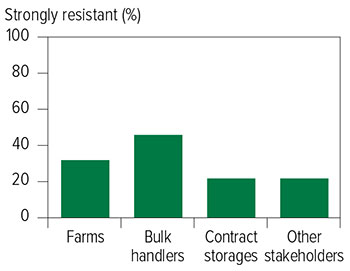Key points
- Strong resistance to phosphine in rusty grain beetle has increased substantially since the first resistant population was discovered in 2007
- The rusty grain beetle is mobile and resistant populations are present across the full spectrum of the grain supply chain
- Area-wide integrated pest and resistance management has the potential to suppress this problematic species indefinitely
Increasing phosphine resistance in rusty grain beetle requires a new approach: area-wide integrated pest resistance management.
Rusty grain beetle (Cryptolestes ferrugineus), one of the flat grain beetles, is a serious threat to Australia’s reputation as a provider of insect and residue-free grain. High levels of resistance to the fumigant phosphine – up to 1200 times in some populations in Australia – is rendering label rates ineffective.
A better understanding of the geographic spread of resistant populations and the genetic basis for resistance has the potential to guide the development of effective region-specific integrated pest and resistance management practices.
The Queensland Department of Agriculture and Fisheries has coordinated analysis of resistant populations of rusty grain beetle throughout eastern Australia. Complementary research programs were conducted in collaboration with the NSW Department of Primary Industries through GRDC investment and with the University of Queensland as part of the Australia-India Strategic Research Fund. This research has painted an intricate picture of increasing levels of resistance throughout the grain value chain, including on-farm.
Researchers collected 365 grain samples from bulk handling companies, 136 from farms, 105 from contract storages and 50 from other stakeholders – such as seed merchants and feed mills – during three seasons from 2017-18 to 2019-20.
Resistance frequencies
When resistant populations were first identified in 2007, the rate of incidence was about five per cent and populations were mainly confined to bulk handlers, where the vast majority of grain was stored.
But the increasingly diversified market means larger quantities of grain are being stored on-farm and by other stakeholders – and over longer periods. This has led to an increase in the number of phosphine fumigations per storage site each year. The rusty grain beetle’s ability to fly over large distances and infest multiple commodities has compounded the resistance challenge.
Figure 1: Percentage of grain samples infested by rusty grain beetle at different storage sites in the grain supply chain from 2017–20. 
Source: Dr Raj Jagadeesan
Results from the latest study showed that nearly 50 per cent of the samples collected from bulk handlers, farms and other stakeholders contained rusty grain beetle infestations, but only 17 per cent of contract storages were infested (Figure 1).
Resistance testing of samples which contained beetle infestations using laboratory assays showed that strongly resistant insects exist throughout the supply chain in the range of 22 to 46 per cent (Figure 2).
Molecular DNA testing showed that many individuals in the populations harbour a single copy of the resistance gene and express partial resistance. This happens when susceptible and strongly resistant populations mate and produce offspring.
The overall incidence of resistance genes in the population was higher than the proportion of fully resistant individuals, suggesting potential future increases in the frequency of resistant populations.
Area wide
The discovery of widespread resistance throughout the value chain, and the high mobility of the rusty grain beetle population, makes it clear that a coordinated management approach is required for each region.
Figure 2: Percentage of strongly resistant rusty grain beetle detected in the samples, which contained beetle infestations, that were collected from different storage sites in the grain supply chain from 2017–20. 
Source: Dr Raj Jagadeesan
Research will now focus on the development of area-wide integrated pest and resistance management (AW-IPRM) strategies. The AW-IPRM concept dates back to the 1990s and has proven successful in managing several field insect pests.
The approach relies on coordinated suppression of the majority of the pest population (90 per cent) across multiple sectors in a region, rather than near eradication of the total population (99 per cent) at a single sector or a site, and it has the potential to keep the pest population below economic thresholds indefinitely.
Suitable integrated pest resistance management strategies combine non-chemical and chemical pest management tools.
These include aeration and grain cooling, restricting phosphine fumigations to sealable gas-tight silos with strict adherence to label rates, rotating phosphine with sulfuryl fluoride – a phosphine resistance breaker – and using grain protectants or diatomaceous earth wherever possible.
More information: Dr Raj Jagadeesan, 0401 957 059, raj.jagadeesan@daf.qld.gov.au

























































